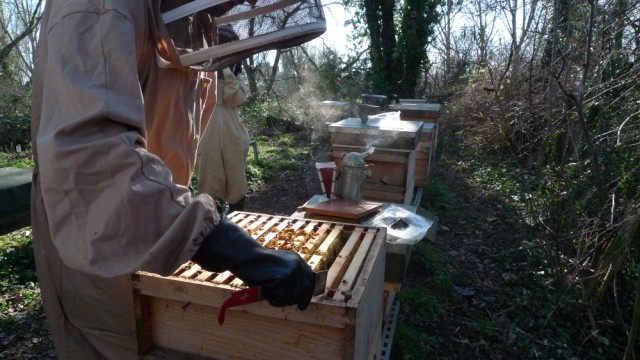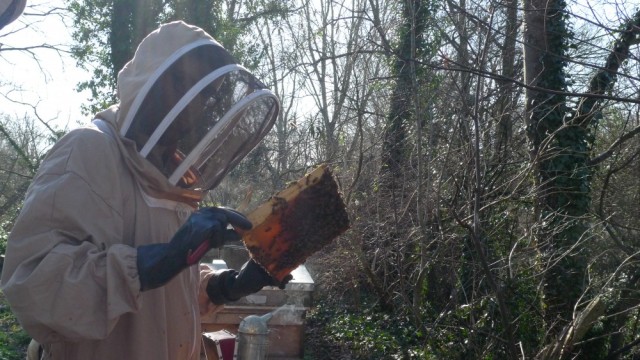50:50 because two are doing well and two not so well, and 50:50 because that’s probably the chance of the two doing not so well making it.
Today was a magnificent spring day, sunny and warm, around 14ºC (57ºF) I believe. Such a bonny day that we dared peek inside our hives for the first time in 2015.
Above you can see Jonesie inspecting. He had quite an audience of excited beekeepers – it has been very hard for us not being able to see our bees all winter. All was well in his hives, the bees were in a good mood and they were packed full of honey.
After some tea, cake and chatting, Emma and I went down to look at our bees. Since October we have only been peering in at the top, checking up on the fondant and only once very quickly removing the crown board to do the oxalic acid anti-varroa treatment.
Inside Melissa and Pepper’s hives, it was obvious all was well as they were bursting out from the crown board, busy eating their fondant. Stuck inside Pepper’s mouse guard I found a recently deceased drone – so perhaps Pepper is laying the first drones of the season already! Either that or he overwintered with the colony, that is quite unusual but not unheard of. I removed their mouse guard as the colony was so vibrant no intruding mouse’s nose would stand a chance.
I ventured further inside Chili and Chamomile’s colonies to pull out frames, as they seemed worrying quiet. It does not look good in there – mouldy honey stores in Chili’s and some brood which had been uncapped by the bees. It looked like Chili’s bees were struggling to keep the brood warm, so Emma placed dummy boards around the three frames the bees were on to try and keep them insulated. She also gave them some sugar syrup as well as fondant, now that the temperatures are rising we can start using syrup again.
We saw both Queen Chili and Queen Chamomile, but both of them are barely laying, there was very little brood in either hives. There could be a few reasons for this – running out of sperm, a lack of nurse bees to care for the brood or perhaps nosema infection. Nosema can damage a queen’s ovaries and cause them to shrink. Sigh.
Plan for next week – transfer one of the weak colonies to our spare nuc. Consider combining the two and plan when to do our shook-swarms. Will be busy hammering up new brood frames this week, eleven needed per hive!
To end on a cheerier note, here’s some pics of pretty crocuses and snowdrops. Some of the less sunny photos were taken last week.








Sorry to hear, and wishes for the best.
LikeLike
Thank you. There are so many things that can go wrong with bees it’s a wonder they stay alive at all!
LikeLike
Keep up the good work, love your posts!
LikeLike
Thanks very much 🙂
LikeLike
Oh dear! All’s not lost though, Emily. I’m a believer in strengthening weak colonies this time of year with a frame of almost emerging brood from your strong colonies. It can make a huge difference very quickly. And repeat in a week or two. Hope they pull through. Bill
LikeLike
Thanks Bill, I’ll let Emma know your advice and we can talk it over. As we’re hoping to shook-swarm the strong colonies at some point that could work, instead of destroying their brood we could give it to the weak colonies.
If the two queens turn out to be irretrievably weakened by nosema, do you think the bees have a chance of producing a new queen using eggs from another colony and her getting mated at this time of year? It seems to be too early to buy a UK mated queen and I don’t want to import a queen. We are wary of combining the weak bees with the strong colonies in case that spreads disease.
LikeLike
I agree with Bill. A frame of brood from Pepper’s hive to Chili’s could save the colony and preserve the bloodline as Pepper is Chili’s daughter too 🙂 We could take a frame from Melissa’s brood for Chamomile too though they are different lines of queens it would at least give Chamomile’s workers a chance to get some younger nurse bees hatching in there to get the colony back on its feet. If the weaker colonies can grow a bit we can then shook swarm them into nucs or reduced-sized hives with dummy boards later in spring to finally get rid of the diseased comb. All is not lost yet!
LikeLike
I really enjoy your blog, beautiful pictures too!
I hope your queens sort themselves out, anything can happen at this time of the year…
I’ll be making up frames this week too!
LikeLike
Thanks Helen, nice to meet other London beekeepers on here. I love the photos of crocuses on your blog.
LikeLike
Thank you!
LikeLike
I really like reading your bee stories, much better when all the hives are healthy though. I hope you get your weak colonies healthy again.
LikeLike
Me too, thanks Donna.
LikeLike
I hope the higher temperatures and the sugar syrup give the hives the boost they need. Amelia
LikeLike
Thanks Amelia. It’s hard to see them not doing well when we have tried so hard to nurture them during the year. You will understand as you are a bee and nature lover yourself.
LikeLiked by 1 person
Oh – I hope you can rescue them!
A friend in the village has just ordered one of those fancy Australian beehives – I nodded sagely when he told me and pretended to be an expert based on what I’ve read here. Maybe I shall muscle in on his attempt to become a beekeeper – I think I know enough to act in a supervisory capacity. Well – of the tea and cakes at least.
LikeLike
Thank you. Very exciting that your friend has ordered a Flow hive, would be interested to hear how he gets on. Good that he has you to supervise and make sure he doesn’t forget the tea and cakes, an essential part of the beekeeping process of course.
LikeLike
Well, you know I am feeling your pain. Good luck!
LikeLike
Thanks. They are still alive this week, but not sure for how much longer.
LikeLike
Fingers crossed for your strugglers and best wishes for a bountiful summer.
LikeLike
Thanks very much Theresa.
LikeLike